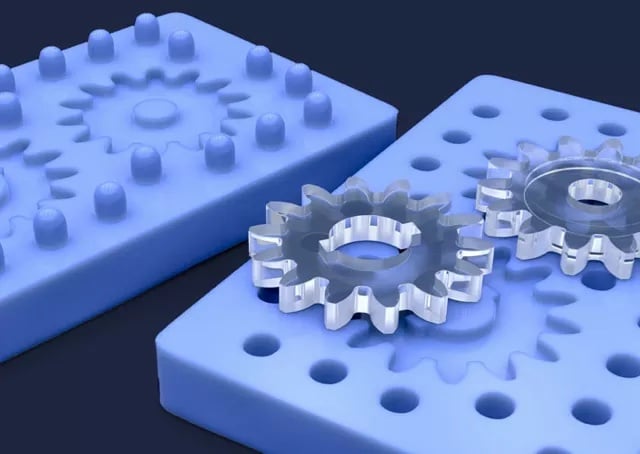
Shapeways offers a wide range of advanced materials and technology for businesses designing high-quality prototypes and functional, end-use parts. Whether designers and engineers are engaged in making highly customized products at a low volume, or mass producing industrial parts, they may be considering transitioning from traditional manufacturing to 3D printing–or vice versa, depending on project requirements.
Always agnostic in terms of materials and technologies, Shapeways continues to focus on guiding customers toward the best choices for a specific application, considering design requirements and complexity of parts, the volume needed, projected time and cost, and suitable resources. While traditional manufacturing offerings include common technology like Injection Molding and CNC Machining, Shapeways also provides access to technology like Urethane Casting, which can be similar to Injection Molding and serve as the better option in some cases.
Understanding Urethane and its Origins in Manufacturing
Present in manufacturing for almost a hundred years, polyurethane is a resin material serving to make a wide range of products via molds for many different applications. Organic copolymers polyol and diisocyanates or polymeric isocyanates come together to form polyurethane resin materials that are extremely adaptable and used as elastomers, adhesives, coatings, sealants, and much more.
German chemists originally developing polyurethane found the material could be mixed with nylon for greater flexibility, and it was introduced further during World War II as a less expensive alternative to rubber. Initially known as a suitable material for insulation and different types of foam, the material evolved into adhesives and cushions with the inception of polyurethane that could be molded.

Why Urethane Casting is Still So Relevant in Traditional Manufacturing
Urethane Casting is often desired for manufacturing smaller volumes of parts, relying on molds that are generally made out of more malleable materials like silicone. As a comparison, Injection Molding is another technology relying on materials that are melted inside molds, solidified, and then released as a final product. For either technology, master patterns must be created; however, for Injection Molding, the molds are usually made out of metal. This means they are capable of repetitive use in exponentially more production runs, able to retain excellence in accuracy and repeatability over the long term.
Versatility is a big selling point in manufacturing, which leads to the continued popularity of Urethane Casting, winning out in the oft-discussed question of Urethane Casting vs. Injection Molding. Much of this revolves around the ability to make different kinds of molds, without being restricted to the expense and time-consuming creation of metal molds.
“The vast material selection available for Urethane Casting is a great benefit,” said Thomas Murphy, Senior Product Manager, Physical Products at Shapeways. “This technology provides many material options for functional, durable parts as well as offering colors not always available in additive manufacturing.”
While stronger more durable metal molds make sense for mass production, Urethane Casting allows for patterns to be made with more freedom. It is possible to 3D print master patterns for Urethane Casting in fact, speeding up the manufacturing process substantially, along with providing the potential to create different types of shapes, details and channels. Depending on the project, Urethane Casting may lead to the maximum output and speed required–and with 3D printing, allows for complementary technologies to offer greater value and more efficient production and turnaround times.

How Does Urethane Casting Prototypes and Parts Work?
Generally employed for industrial-level production, Urethane Casting is considered a better option for manufacturers seeking middle ground between prototyping and large-volume production. This technology is further refined at Shapeways due to extensive experience in additive manufacturing.
While silicone molds are popular for many applications, Shapeways also relies on materials like Accura Xtreme for 3D printing specialized master patterns via Stereolithography (SLA), a technology known for creating extremely accurate, highly detailed parts. Although they are usually only expected to last for smaller production runs, the 3D printed molds for Urethane Casting are faster and easier to make, and cut down on tooling and part costs.

Common Applications for Urethane Casting
Shapeways uses Urethane Casting to make an extremely wide range of products, beginning with prototypes. Whether designers are making models for a sales presentation or an architectural display, prototypes made via Urethane Casting are popular in low volumes. This is especially true for prototypes being made during the product development process. If a customer could feasibly be making a hundred iterations, Urethane Casting for prototypes is an excellent option due to the efficiency in production as well as the more economical aspect in comparison to more traditional manufacturing. This technology is often used for more functional parts too like shock absorbers, and wheels and rollers in a variety of consumer applications.
About Shapeways
Enjoy the benefits of this advanced technology and a wide range of materials from Shapeways for 3D printing your creations with accuracy, complex detail, and no minimum or limits in terms of mass customization or single part orders. Shapeways has worked with over 1 million customers in 160 countries to 3D print over 21 million parts! Read about case studies, find out more about Shapeways additive manufacturing solutions, and get instant quotes here.


